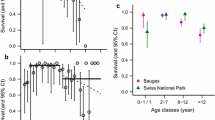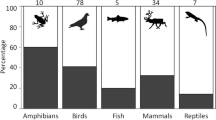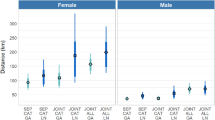Abstract
Adult survival probability is a key parameter in any population model for a long-lived species. For many species, information on adult survival comes from a capture–recapture study involving individuals for whom age is unknown. If the species experiences senescence, the estimate of overall adult survival probability will be negatively biased. The purpose of this paper is to assess the extent to which the estimate is biased and the implications for population modelling. We show that the amount of bias depends on the capture probability and the strength of senescence. If the capture probability is greater than 0.5, the expected bias is at most 1%, unless senescence is strong and begins early in adulthood. Individual heterogeneity in capture probability can also lead to negative bias in estimates of survival probability, meaning that moderate effects from senescence and heterogeneity may combine to produce a non-negligible amount of bias. Capture–recapture methods for survival are also used to estimate the time that migrating animals spend at intermediate “stop-over” sites. In this context, an increase in departure probability with time since arrival is analogous to senescence, leading to a negative bias in estimated stop-over duration. This bias will often be large because capture probabilities in such studies are generally very low and departure probability may increase abruptly once animals have rested and re-fueled.
Access this chapter
Tax calculation will be finalised at checkout
Purchases are for personal use only
Similar content being viewed by others
References
Aebischer NJ, Coulson JC (1990) Survival of the kittiwake in relation to sex, year, breeding experience and position in the colony. Journal of Animal Ecology 59:1063–1071.
Bradley JS, Wooller RD, Skira IJ, Serventy DL (1989) Age-dependent survival of breeding short-tailed shearwaters Puffinus tenuirostris. Journal of Animal Ecology 58:175–188.
Burnham KP, Anderson DR, White GC, Brownie C, Pollock KH (1987) Design and analysis methods for fish survival experiments based on release-recapture. American Fisheries Society Monograph 5.
Burnham KP, White GC (2002) Evaluation of some random effects methodology applicable to bird ringing data. Journal of Applied Statistics 29:245–264.
Carothers AD (1973) The effects of unequal catchability on Jolly–Seber estimates. Biometrics 29:79–100.
Carothers AD (1979) Quantifying unequal catchability and its effect on survival estimates in an actual population. Journal of Animal Ecology 48:863–869.
Caswell H (2000) Matrix population models: construction, analysis, and interpretation. 2nd edn. Sinauer, Massachusetts.
Caughley G (1966) Mortality patterns in mammals. Ecology 47:906–918.
Cormack RM (1979) Models for capture–recapture. In: Cormack RM, Patil GP, Robson DS (eds) Sampling biological populations. International Co-operative Publishing House, Fairland, Maryland, pp 217–255.
Crespin L, Harris MP, Lebreton J-D, Wanless S (2006) Increased adult mortality and reduced breeding success with age in a population of common guillemot Uria aalge using marked birds of unknown age. Journal of Avian Biology 37:273–282.
Dunnet GM, Ollason JC (1978) The estimation of survival rate in the fulmar, Fulmarus glacialis. Journal of Animal Ecology 47:507–520.
Efford MG (2000) Possum density, population structure and dynamics. In: Montague T (ed) The brushtail possum biology, impact and management of an introduced marsupial. Manaaki Whenua Press, Christchurch, Chapter 5, pp 47–61.
Efford MG (2005) Migrating birds stop over longer than usually thought: comment. Ecology 86:3415–3418.
Gaillard J.M, Allainé D, Pontier D, Yoccoz NG, Promislow DEL (1994) Senescence in natural populations of mammals: a reanalysis. Evolution 48:509–516.
Gaillard J-M, Viallefont A, Loison A, Festa-Bianchet M (2004) Assessing senescence patterns in populations of large mammals. Animal Biodiversity and Conservation 27:47–58.
Heppell SS, Caswell H, Crowder LB (2000) Life histories and elasticity patterns: perturbation analysis for species with minimal demographic data. Ecology 81:654–665.
Kaiser A (1995) Estimating turnover, movements and capture parameters of resting passerines in standardized capture–recapture studies. Journal of Applied Statistics 22:1039–1047.
Lebreton J-D, Burnham KP, Clobert J, Anderson DR (1992) Modeling survival and testing biological hypotheses using marked animals: a unified approach with case studies. Ecological Monographs 62:67–118.
Loery G, Pollock KH, Nichols JD, Hines JE (1987) Age-specificity of black-capped chickadee survival rates: analysis of capture–recapture data. Ecology 68:1038–1044.
Loison A, Festa-Bianchet M, Gaillard J-M, Jorgenson JT, Jullien JM (1999) Age-specific survival in five populations of ungulates: evidence of senescence. Ecology 80:2539–2554.
McDonald DB, Fitzpatrick JW, Woolfenden GE (1996) Actuarial senescence and demographic heterogeneity in the Florida Scrub Jay. Ecology 77:2373–2381.
Manly BFJ (1970) A simulation study of animal population estimation using the capture–recapture method. Journal of Applied Ecology 7:13–39.
Morris S, Turner EM, Liebner DA, Larracuente AM, Sheets DA (2005) Problems associated with pooling mark-recapture data prior to estimating stopover length for migratory passerines. In: Ralph CJ, Rich TD (eds) Bird conservation, implementation and integration in the Americas: proceedings of the third international Partners in Flight conference 2002. General Technical Report PSW–GTR–191, USDA Forest Service, Pacific Southwest Research Station, Albany, California, pp 673–679.
Newton I, Rothery P (1997) Senescence and reproductive value in sparrowhawks. Ecology 78:1000–1008.
Nichols JD, Hines JE, Blums P (1997) Tests for senescent decline in annual survival probabilities of common pochard, Aythya ferina. Ecology 78:1009–1018.
Niel C, Lebreton J-D (2005) Using demographic invariants to detect overharvested bird populations from incomplete data. Conservation Biology 19:826–835.
Orell M, Belda EJ (2002) Delayed cost of reproduction and senescence in the willow tit Parus montanus. Journal of Animal Ecology 71:55–64.
Pledger SA (2006) Age-related capture–recapture parameter estimation when true age is unknown. Technical Report, School of Mathematics, Statistics and Computer Science, Victoria University of Wellington, New Zealand.
Pledger S, Efford MG, Pollock K, Collazo J, Lyons J. (2008) Stopover duration analysis with departure probability dependent on unknown time since arrival. In: Thomson DL, Cooch EG, Conroy MJ (eds.) Modeling Demographic Processes in Marked Populations. Environmental and Ecological Statistics, Springer, New York, 3:349–364.
Pollock KH, Nichols JD, Brownie C, Hines JE (1990) Statistical inference for capture–recapture experiments. Wildlife Monographs 107:1–97.
Pradel R (1996) Utilization of capture–mark-recapture for the study of recruitment and population growth rate. Biometrics 52:703–709.
Promislow DEL (1991) Senescence in natural populations of mammals: a comparative study. Evolution 45:1869–1887.
Pugesek BH, Nations C, Diem KL, Pradel R (1995) Mark-resighting analysis of a California gull population. Journal of Applied Statistics 22:625–639.
R Development Core Team (2006) R: a language and environment for statistical computing. R Foundation for Statistical Computing, Vienna, Austria. http://www.R-project.org.
Rexstad EA, Anderson DR (1992) Heterogeneous survival rates of mallards (Anas platyrhynchos). Canadian Journal of Zoology 70:1878–1885.
Schaub M, Pradel R, Jenni L, Lebreton J-D (2001) Migrating birds stop over longer than usually thought: an improved capture–recapture analysis. Ecology 82:852–859.
Seber GAF (1982) The estimation of animal abundance and related parameters. 2nd edn. Griffin, London.
Sheil D, May RM (1996) Mortality and recruitment rate evaluations in heterogeneous tropical forests. Journal of Ecology 84:91–100.
Sidhu LA, Catchpole EA, Dann P (2007) Mark-recapture-recovery modeling and age-related survival in Little Penguins (Eudyptula Minor) The Auk 124:815–827.
Williams BK, Conroy MJ, Nichols JD (2002) Analysis and management of animal populations. Academic Press, London.
Wooller RD, Bradley JS, Croxall JP (1992) Long-term population studies of seabirds. Trends in Ecology and Evolution 7:111–114.
Yearsley JM, Fletcher D (2002) Equivalence relationships between stage-structured population models. Mathematical Biosciences 179:131–143.
Zens MS, Peart DR (2003) Dealing with death data: individual hazards, mortality and bias. Trends in Ecology and Evolution 18:366–373.
Author information
Authors and Affiliations
Corresponding author
Editor information
Editors and Affiliations
Rights and permissions
Copyright information
© 2009 Springer Science+Business Media, LLC
About this chapter
Cite this chapter
Fletcher, D., Efford, M.G. (2009). Effect of Senescence on Estimation of Survival Probability When Age Is Unknown. In: Thomson, D.L., Cooch, E.G., Conroy, M.J. (eds) Modeling Demographic Processes In Marked Populations. Environmental and Ecological Statistics, vol 3. Springer, Boston, MA. https://doi.org/10.1007/978-0-387-78151-8_47
Download citation
DOI: https://doi.org/10.1007/978-0-387-78151-8_47
Publisher Name: Springer, Boston, MA
Print ISBN: 978-0-387-78150-1
Online ISBN: 978-0-387-78151-8
eBook Packages: Mathematics and StatisticsMathematics and Statistics (R0)




